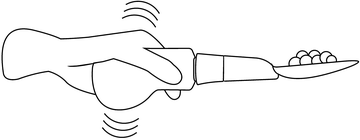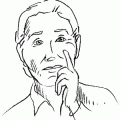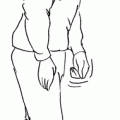and Kelvin L. Chou2
(1)
Parkinson’s Clinic of Eastern Toronto & Movement Disorders Centre, Toronto, ON, Canada
(2)
Michigan House, University of Michigan Medical School, Ann Arbor, MI, USA
Keywords
Pharmacologic treatmentNon-invasive devicesDeep brain stimulationThalamotomyNon-pharmacologic Treatment
Not all patients need to be started on medications. Some patients with ET may desire nothing more than to be assured that they do not have Parkinson disease. Others may decide that the tremors are not disabling enough to take medications. Any exacerbating factors, if present, should be addressed first. Tremor-inducing medications should be discontinued (see Chap. 4 for frequent drugs that induce tremors). The avoidance of stimulants such as caffeine may be helpful. Metabolic problems, such as hyperthyroidism, should also be looked for and treated [1].
Because alcohol may transiently reduce tremor amplitude in about 50–75 % of the cases [2–4], some patients may drink a glass of wine or beer at social events in order to calm down their tremors. These patients may notice a worsened tremor (rebound tremor) when the effect of alcohol wears off [4]. In general though, increased alcohol intake is not recommended for treatment of essential tremor.
Stress reduction may be helpful, though may not be easily achieved. There is no evidence that physical therapy interventions improve tremor. Cooling the upper limbs in cold water for about 5 min causes temporary reduction in essential tremor, but there are no data on the length of effectiveness of this technique over 30 min, and this technique may be too uncomfortable for most patients [5].
Non-invasive Devices
Non-invasive devices such as weighted utensils or weighted wrist bracelets are often suggested. Unfortunately, there is only limited evidence that weights reduce action tremor [5]. It is the author’s experience that weights are most helpful for mild essential tremor, and that only some patients find it beneficial.
Tremor suppressing orthoses have been studied [6, 7]. These devices detect tremors from voluntary motion and use loading approaches to suppress pathologic tremors, but they are not readily available to the public. Furthermore, they may cause a lot of discomfort, and the bulk, weight, and structure of the device is likely to prevent widespread acceptance.
A handheld, non-invasive device (Liftware http://www.liftlabsdesign.com/, see Fig. 5.1) that can stabilize a spoon for eating has been recently developed [8]. This device senses the direction of a person’s tremor and moves the spoon in the opposite direction in order to stabilize the spoon. It reduces tremor amplitude by about 70 % with eating tasks when tested in individuals with ET [8]. The device is light and contains a rechargeable battery that can last for several meals.


Fig. 5.1
Liftware device showing stabilization of a spoon despite tremor in the hand (Illustration by John Redmond)
Pharmacologic Treatment
Two medications are considered first-line treatment for ET: propranolol (a beta-blocker) and primidone (a GABA agonist) [9–11]. After these two agents, others, such as topiramate, gabapentin, other beta-blockers, and benzodiazepines may be tried (see Table 5.1 for a summary of medications used for ET) [10, 11]. Pharmacological treatments are generally considered to be effective in 50 % of patients with essential tremor [9, 12]. Additionally, many patients have difficulty tolerating these medications [12].
Table 5.1
Pharmacological agents used in the treatment of essential tremor
Drug | Dose | Side effects | Comments |
|---|---|---|---|
Primidone | Starting dose is 25 mg daily, increased slowly up to total dose 750 mg daily | Sedation, fatigue, drowsiness, nausea, vomiting, malaise and dizziness | GABA agonist |
Propranolol | Starting dose is 20 mg three times daily, increased slowly up to total dose 320 mg daily | Lightheadedness, bradycardia, drowsiness, impotence, fatigue, depression | B1& B2 antagonist |
Propranolol LA | Starting dose is 60 mg once daily, increased slowly up to 320 mg/day | Skin rash, lightheadedness and dizziness | Same as propranolol but long acting |
Topiramate | Starting dose is 25 mg once daily, increased weekly by 25 mg to the maximum dose of 200 mg twice daily | Weight loss, paresthesias, concentration difficulties, exacerbation of glaucoma and renal stones | Sodium channel blocker |
Gabapentin | Starting dose is 300 mg once daily, increased over few days to 300–900 mg three times daily | Fatigue, dizziness, nervousness, lethargy | Alpha-2-delta calcium channel subunit blocker |
Atenolol | Starting dose is 50 mg once daily, maximum 150 mg/day | Lightheadedness, nausea, cough, dry mouth, sleepiness | B1 antagonist |
Sotalol | 80 mg twice daily | Blurred vision, shortness of breath, lightheadedness | B1 & B2 antagonist, acting mainly peripherally |
Alprazolam | Starting dose is 0.25 mg three times daily, increased slowly up to 1 mg three times daily | Fatigue, drowsiness, abuse potential | Benzodiazepine |
Clonazepam | Starting dose is 0.5 mg once daily, increased slowly to 2 mg three times daily | Lethargy | Benzodiazepine |
Nadolol | Starting dose is 40 mg once daily, maximum 240 mg/day | Dizziness | B1& B2 antagonist |
Nimodipine | Starting dose is 30 mg once daily, increased slowly to maximum 120 mg/day divided three times daily | Headaches and heartburn | Ca channel blocker |
Botulinum toxin A for head tremor | Dose ranges from 50 to 400 units depending upon the muscles involved and degree of tremor | Excessive weakness of injected muscles, dysphagia, injection pain | Injected every 3–4 months |
Botulinum toxin A for hand tremor | Dose is variable, from 50 to 100 Units/arm | Hand and finger weakness, pain at injection site | Injected every 3–4 months |
Botulinum toxin A for voice tremor | 0.5–15 Units | Hypophonia, dysphagia | Injected every 3–4 months |
Propranolol
Propranolol use for essential tremor was introduced in 1971 [13]. Among the different beta-blockers, none is considered to be superior to propranolol [9–11]. The mechanism of action of beta-blockers in ET involves antagonism of peripheral beta-adrenergic receptors in muscles, so drugs that are predominantly central acting B-1 antagonists appear to be less effective than those that act predominantly on peripheral B-2 receptors [14, 15]. Propranolol is a nonselective beta-adrenergic receptor antagonist. Some patients may take propranolol only before social engagements whereas others may use it on a daily basis. If propranolol is to be taken on daily basis, the dosage ranges from 60 to 320 mg, divided into two to three doses per day [9, 11]. Propranolol is effective in treating essential tremor involving limbs, and many studies have shown that the magnitude of tremor is reduced by at least 50 % as measured by accelerometry and clinical rating scales [9, 10].
Side effects include a drop in blood pressure, fatigue, depression, impotence and bradycardia. Propranolol is contraindicated in patients with severe asthma, COPD or heart failure. Diabetes mellitus is also a relative contraindication as propranolol can mask symptoms of hypoglycemia.
Primidone
Primidone, originally used as an antiepileptic medication, improves tremor significantly in patients with ET. Primidone acts by enhancing GABAergic tone in the central nervous system. It comes in 50 mg and 250 mg formulations. The initial dose is half of a 50 mg tablet (25 mg) which is then titrated slowly upwards. The average reduction in tremor is at least 50 % when measured by the clinical rating scales and accelerometry [10]. Though similar in effectiveness to propranolol, tolerance is an issue with primidone [9, 12]. One third of the patients may have a strong feeling of being unwell with the first dose that may be so strong that patients refuse to continue on primidone [9]. However, these side effects may improve with longer exposure. Other common side effects include drowsiness, dysequilibrium and dizziness. Because of the drowsiness, patients may tolerate it better if given at bedtime.
Combined Primidone/Propranolol
Combined treatment with propranolol and primidone may possibly be more effective than monotherapy with either of these agents alone, probably because of their different mechanisms of action. In one study, primidone, at doses of 50–1,000 mg/day decreased tremor amplitude in ET by 60–70 % when added to propranolol, compared to only a 35 % reduction in tremor with propranolol only (mean dose of 260 mg/day) [18]. Unfortunately, this issue has not been studied in a randomized, controlled fashion.
Other Therapies
Topiramate is a sodium channel blocker whose common indications include epilepsy and prophylaxis of migraine. Topiramate has been studied in three double-blind, placebo-controlled, crossover studies, and improves tremor severity, motor task performance, and functional disability, as measured by the clinical rating scales, by approximately 30 % [19]. The initial starting dose of topiramate is 25 mg once a day, but the mean dosage in these trials was approximately 250 mg a day, divided into two daily doses. Side effects include decrease in appetite, weight loss, paresthesias, concentration difficulties, exacerbation of glaucoma and renal stone.
Gabapentin may have a mild beneficial effect on essential tremor. In one double-blind, placebo-controlled, crossover trial in 16 patients, gabapentin at a dose of 1,200 mg/day had similar tremor effect to propranolol, and both were better than placebo in all tremor measures (clinical and accelerometry) [20]. In another double-blind, placebo-controlled, cross-over trial using gabapentin as adjunctive therapy in ET, tremor rating scores improved, but accelerometry scores did not improve [21]. A separate, double-blind, placebo-controlled, crossover trial of gabapentin as adjunctive therapy reported no difference between placebo and gabapentin at a dose of 1,800 mg/day [22]. The side effects of gabapentin include fatigue, dizziness, nervousness and lethargy.
As mentioned above, other beta-blockers may also be used, though none are considered as good as propranolol. Atenolol results in approximately 25 % mean improvement on clinical tremor rating scales and a 37 % improvement by accelerometry [10, 23]. Clinically effective doses range between 50 and 150 mg per day. Side effects are similar to propranolol and include lightheadedness, nausea, cough, dry mouth and sleepiness. Nadolol, at a dose of 120–240 mg daily, has been demonstrated to improve tremor in ET, but only in patients who previously responded to propranolol [24]. Sotalol is another nonselective beta-adrenergic receptor antagonist that was shown to effectively reduce tremor in a double-blind placebo-controlled trial at a dose of 80 mg twice daily [15].
Benzodiazepines may be helpful for essential tremor. In small, double-blind studies, alprazolam has demonstrated benefit for limb tremor in ET that is superior to placebo [25] and equivalent to primidone [26]. The dose range for alprazolam is 0.75–3 mg/day. Use of alprazolam is cautioned due to its abusive potential [10]. Side effects include lightheadedness, nausea, cough, dry mouth and sleepiness. Clonazepam decreased tremor by about 71 % in a small study of 14 patients with kinetic limb tremor due to ET [27]. Effective doses for clonazepam range from 0.5 to 6 mg/day. Side effects include drowsiness. Similar to alprazolam, there is also potential for abuse and possibility of withdrawal symptoms associated with clonazepam, and therefore it should be used with great caution [10].
Nimodipine may potentially benefit patients with limb tremor. In one small study looking at 30 mg four times daily, 8/16 ET patients who had never been treated with other medications noticed improvement in their tremor [28]. The side effects include headache and heartburn. Pregabalin and zonisamide may also be helpful, though the literature has reported mixed results, with some studies showing effectiveness in ET, while others show no difference from placebo [10].
Botulinum toxin has been used to treat hand, head and voice tremor in essential tremor. It can improve postural hand tremor by about 50–68 %, but the incidence of finger or wrist weakness is high (approximately 70–90 % of patients) [29, 30]. For head tremor, there has been only one randomized trial. In this trial, five subjects had moderate to marked improvement in head tremor on clinical rating scales compared to only one subject with improvement who was given placebo [31]. The side effects included pain at the injection site and weakness. There have been two open label studies of botulinum toxin type A for voice tremor [32, 33]. In one study, about a 22 % improvement with unilateral injections and a 30 % improvement with bilateral injections was noticed in voice tremor [33]. In the other study, 67 % of the patients subjectively felt that their voice was improved [32]. When used to treat voice tremor, botulinum toxin may cause hoarseness of voice and swallowing difficulties. At this point, botulinum toxin injections for limb, head and voice tremor should be considered only in medically refractory cases [10, 11].
Surgical Treatment
Surgical treatment should be considered for a patient with essential tremor when: (1) the tremors are disabling and interfere with a patient’s quality of life and (2) the tremors do not respond to standard medical therapies. Dementia is a contraindication to surgical procedures. Surgical centers typically do not consider potential candidates until they have failed the first-line therapies propranolol and primidone. A common mistake is marking a tremor medication as “failed” when the medication was not titrated to a high enough dose (see Table 5.1 for maximal doses of the commonly used tremor medications). Thus, prior to surgery, patients should be evaluated by a movement disorders specialist. Two types of surgical treatments are available; deep brain stimulation (DBS) and thalamotomy (see Table 5.2 for a comparison of surgical treatments).
Table 5.2
Surgical treatments for essential tremor
Technique | Side effects | Comments |
|---|---|---|
Deep brain stimulation of the thalamus | Due to procedure: intracranial hemorrhage, stroke | Marked improvement in limb tremor, insufficient evidence for voice and head tremor, side effects are less than thalamotomy |
Hardware malfunction | ||
Due to stimulation: dysarthria, paresthesias, dystonia, postural instability, ataxia, and limb weakness
Stay updated, free articles. Join our Telegram channel
Full access? Get Clinical Tree
 Get Clinical Tree app for offline access
Get Clinical Tree app for offline access

|



